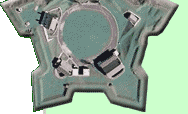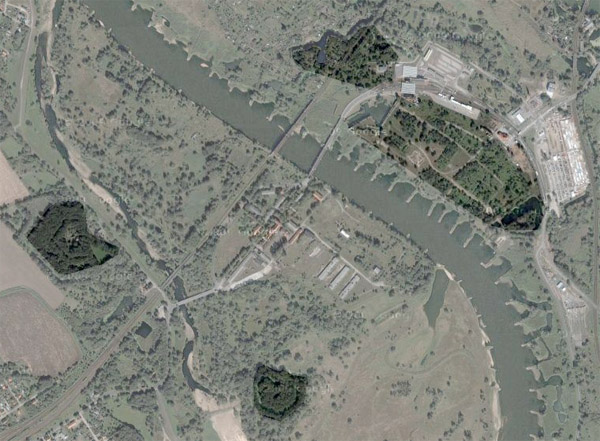
 |
 |
Fortifications of Kostrzyn Kostrzyn, Poland |
 |
 |

|
 |
 |
||
 |
Kostrzyn (known as Kuestrin by its Germanic inhabitants), at the confluence of the Oder and Warta rivers, was first settled by Germanic people. Slavs showed up and pushed the Germans out in the 9th century, and the two have been pushing each other back & forth ever since. By the 12th century Kostrzyn was a Polish fortified outpost with a romantic-sounding "taxation chamber." Kostrzyn prospered over the next few centuries, thanks to trade brought by heavy river traffic. The town was ruled by Germanic Knights Templar and then the Margraviate of Brandenburg, the latter of whom built a proper castle at Kostrzyn from 1535 to 1571. Over time this castle was expanded into the biggest fortress in the region. Prussian King Frederick the Great (1712-1786) spent most of 1730 and 1731 imprisoned at Kostrzyn, having attempted to flee from his authoritarian father, Frederick William I (1688-1740), to England. The Seven Years War (1756-1763), the first truly global conflict, brought Russian troops to Kostrzyn in 1758. The fort and city were besieged, captured and put to the torch. The Russians then galloped off to participate in the Battle of Zorndorf on August 25, which was one of the bloodiest battles fought in the 18th century. Though the battle was ultimately inconclusive, Kostrzyn was at least relieved of its Russian burden. The French swept into the area in 1806 as part of Napoleon (1769-1821)'s master plan to dominate the universe. The tall-hatted troops stayed put until 1814, when they burned all of Kostrzyn they could (which was just about all of it) before retreating with a Coalition army at their heels. Which finally brings us to the fortifications we're here to adore! Fort Kuerstin, the largest fort darkened in the pic above, was essentially an 1860 upgrade of the castle built in the late 16th century. Even though Germany mopped the floor with France in the Franco-Prussian War (1870-1871), at the end of the 19th century the Germans felt a Franco-Russian alliance would threaten such important rail and river hubs as Kostrzyn. Additional "covering forts" were built close to Kostrzyn over the next 20 years: Fort Gorgast was built on the far side of the river, while Fort Sarbinowo (furthest to the left in the photo above), Fort Czarnow (at the bottom of the picture) and Fort Zabice (just next to the main fort) were built closer in, assumedly to somewhat deflect any massive attacks staged on Kostrzyn...from the east, anyway. All of the money Germany had poured into the defense of Kostrzyn was for naught, for at the completion of the First World War (1914-1918), the much-partitioned nation of Poland was reconstituted, with the Oder river serving as its border with Germany (this was the thirteenth of US President Wilson (1856-1924)'s 14 Points). Germany got to keep Fort Gorgast and some of those lil' fortlets, but the city was now in Poland. The Second World War (1939-1945) proved to be Kostrzyn's undoing. An important rail hub with 32 factories supporting the Axis war effort, plus containing a nazi POW camp in the suburb of Alt-Drewitz and a few forced-labor camps, the city was almost completely demolished by allied bombing. What little was left was comprehensively consumed by the advancing Red Army on its merry way to Berlin in April of 1945. After the war, any Germans still somehow living in Kostrzyn were expelled in a westward direction and replaced with Poles, assumedly whether they wanted to be there or not. Having slowly gotten back on its feet after being completely destroyed, Kostrzyn today mostly concentrates on selling things cheaply to Germans from just across the border: Cheap cigarettes, gas and food are to be found there, as well as what the website www.polandploand.com describes as "some of the ugliest looking shopping centres and supermarket constructions on this planet." This could very well be the case, as they have been there and I have not. A positive event for which Kostrzyn is known is Przystanek Woodstock (Woodstock Stop). Held annually at Kostrzyn since 2004, Przystanek Woodstock is (purportedly) the biggest open-air music festival in Europe, featuring rock bands I've never heard of. In 2009 Przystanek Woodstock drew a crowd of 450,000. |
 |
 |
||
|
|
|||||||
Info Source 1
Info Source 2
Info Source 3
Info Source 4 Info Source 5 Info Source 7 Info Source 8 Info Source 9 Info Source 10 Info Source 11 Thanks to Google Maps for the image! ©2010 starforts.com |
 |